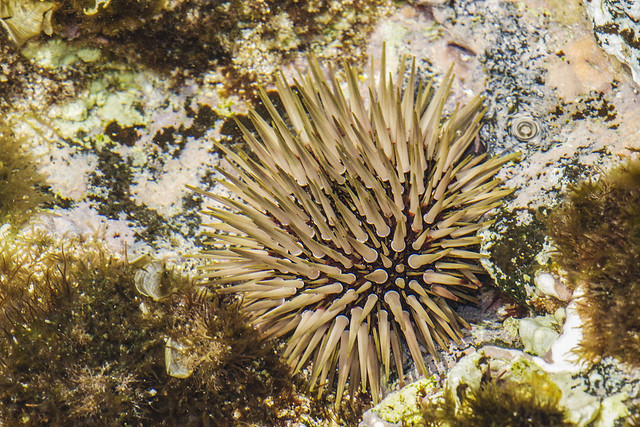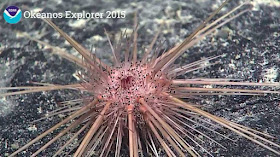
Leg 4 of the Hohonu Moana Okeanos Explorer Expedition has begun! (here is the link to live feed!)
The Hawaiian region brings with it a very different fauna from the one we saw in the Atlantic Okeanos cruises. There's actually quite a bit more diversity in the Pacific in sea stars, and many other echinoderms. So I thought I would offer a guide to some of the more prominent groups of echinoderms that we are likely to encounter in these deep-sea habitats: the sea urchins!!
Most everyone is familiar with the spiny balls that one observes in the intertidal or while SCUBA diving.
And basically, sea urchins in the deep appear the same.. BUT many of them are unusual in some way. Different adaptations or different evolutionary histories and there's much more to them than the "typical" urchins most people encounter in shallower depths.
Here are some of the more commonly encountered sea urchins we will likely encounter in the Hawaiian region (below about 1000 m). These are also pretty typical of deep-sea settings throughout the Indo-Pacific.
There ARE a few that aren't noted here. Mostly the "irregular" urchins such as sand dollars, or sea biscuits.
My thanks in advance to the Facebook screengrab group and Carina M. Gsottbauer
1. Aspidodiadema: This is a genus of unusual deep-sea urchins that is represented in Hawaii and in many tropical deep-sea habitats in the Pacific as well as one species in the Atlantic. These have really long spines that it uses for locomotion in conjunction with its tube feet.
There's apparently more than one species of Aspidodiadema in Hawaii, but so far we've been calling the one seen by Okeanos, Aspidodiadema hawaiiense. Upon looking at both images, there do seem to be some differences but its unclear without a specimen to examine..
Here's a nice moving GIF of this Aspidodiadema species on the move!
Rewatching yesterday's #okeanos dive: sea #urchin moving slowly (Aspidodiadema hawaiiensis) #Hawaii, Lone Cone ~2060m pic.twitter.com/jDatlCvp7S
— Carina M. Gsottbauer (@CarinaDSLR) September 22, 2015
This image shows the same type of animal as the one above but with a mysterious bag like extension emerging from the top. Possibly an anal sac as we see in diadematid urchins?? Unclear.
In comparing them, this second one seems to be lighter in color...
2. Caenopedina! This genus is a member of the family Pedinidae, of which it is the only living member. This genus is widely occurring mostly in deep-sea habitats.
According to the Hawaiian Undersea Research Lab's Animal ID guide, there are two recognized species in the region:
Caenopedina pulchella This species shows these very thick spines which are brightly colored green and purple!
The small individual above seems to have much smaller spines relative to this larger one.. but the colors patterns appear consistent..
This second species is Caenopedina hawaiiensis and it seems to show a very different appearance...
3. Echinothuriid Urchins! These are one of the most frequently encountered sea urchins in deep-sea settings. Commonly referred to as "pancake urchins" or "tam o shanter" urchins, their body shape is suspended by water pressure, so when removed from the ocean into say, a bucket on the deck of a ship, their very soft skeletons collapse into a flat "pancake" like shape.
One caveat about this section: I'm not sure that any of these can be correctly identified..so I'm keeping it vague. At least for now.
But salient features of the urchins as a group include:
1. Needle sharp spines which can be pretty dang painful!
2. Cute little walking legs with special "hooves" on their spines
We've seen at least 2 species.. this purple species..
Rewatching yesterday's #okeanos dive:
sea #urchin w/ mittens on its spines
#Hawaii, Lone Cone ~1800m pic.twitter.com/kEL4cTtBIn
— Carina M. Gsottbauer (@CarinaDSLR) September 22, 2015
There's this slightly different pink echinothuriid
this grey species 
Echinothuriids are a frequently encountered group in the deep-sea. We will likely encounter more of them..
Cidaroids are unusual for urchins in that they lack skin on their spines, which results in an overabundance of "fouling" animals which can settle and grow on them. I've briefly talked about the ecological importance of this here.
We've also seen cidaroids with a CRAZY range of spine shapes and morphologies, such as what I summarized here.
Cidaroids are not just predators on corals as shown below, but are also likely predators on stalked and other crinoids as I've posted about previously..
A nice diversity of cidaroid urchins in the deep-sea Hawaiian Islands.. More at the HURL gallery here. but sadly we've really only seen a few at the deep depths Okeanos has been exploring..
Histocidaris variabilis.. note the barnacles growing on the spines...

Stereocidaris hawaiiensis

Possibly Stylocidaris calacantha. This one was observed high up in the branches of this bamboo coral, likely feeding on the polyps..















god I lovr panckaes
ReplyDelete